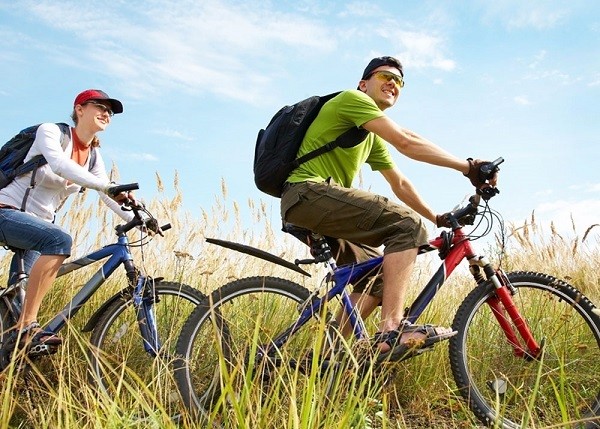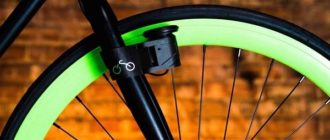Scientists have proven that physical activity cannot be considered a universal way to make your figure perfect and your health “siberian. Bicycling is an effective, but serious tool for self-improvement. Ignorance of the mechanism of burning calories with the help of a popular sport ends up with problems. The presented information will tell you how to expend energy faster on a bicycle and how to correctly calculate the load for maximum benefit to your own body.
How many calories you can burn while cycling
There is no set standard unit of measurement for energy loss while cycling. General formulas do not take into account a number of nuances: riding style, type of bike, headwind, road slope, etc. But it is established: a cyclist in an hour of riding spends more calories compared to a pedestrian, and “long-lasting” fat burning will continue after the walk. The secret lies in the mechanism of reducing stores in fat tissue.
- In trained cyclists, the body works this way: the first 30-50 minutes, glycogen (a source of energy, i.e. calories accumulated by the body during the day) is consumed.
- After an hour, the breakdown of energy-intensive fats begins (1 gram = 9 kcal).
- Burning 100 calories reduces the amount of fat by 50-80 grams.
- Approximate calculations show that a cyclist weighing 70 kg at a moderate ride consumes 270 kcal/hour.
- The figure increases to 500-600 kcal at an above-average rate of riding and reaches 800 kcal with increased training.
During a two-hour walk on a bicycle, the body consumes 700 kcal. If you ride for 2 hours every day for a year, you can lose 30 kg of weight.
Calorie Consumption Calculator
The belief that the human body can handle any physical activity is wrong. The mass craze for cycling is a sign of a healthier society. But every coin has a downside. Stephen Barrer, chief medical officer of the Institute of Neurology (Philadelphia), warns in a study on the benefits and harms of bicycling: muscles should work, not burn. The price in the pursuit of performance can be the health of the athlete. Abusing calorie burning is dangerous.
Starting training, the cyclist should calculate the allowable rate of energy consumption with the help of an online calculator. To do this, the cyclist fills in the basic parameters: gender, age and weight, speed, exercise time. The final figure will be approximate, because the calculator does not take into account the peculiarities of the human body, the type of bicycle and other factors. In this case, you can reduce the error if you specify your body weight (including clothing and backpack) instead of your weight. Below is a calculator for the approximate calculation of kilocalories burned.
The main rules of effective calorie expenditure
9 conditions for achieving positive results:
- Determine your cycling style.
- Choose a road on which to burn maximum calories.
- While riding, the cyclist should change the position and mode of operation. The method used eliminates the habituation of the load and changes the blood supply to the muscles.
- Break the cycling workout into intervals to increase energy expenditure and improve metabolism. For example, cycle for two minutes in easy mode and 30 seconds at high speed.
- Climbing is recognized as an effective calorie absorber. If you ride Uphill—how-to-learn–tips at a speed of 15 km/hour (a difficult task), 1000 kcal are consumed.
- When riding on a horizontal stretch of road, the cyclist expends energy on aerodynamic resistance, rolling tires, overcoming the friction of bicycle mechanisms. To keep up the pace, the rider increases speed to 15 km/hour and burns 420 kcal.
- Watch your heart rate. The normal heart rate is 120-150 beats per minute. At the first reading the cyclist increases the speed of movement, when exceeding the upper limit – reduces and takes a break.
- The bicycle used for training must be multi-speed.
- Bikers are required to take water with them to maintain a drinking regimen.
What style of riding burns calories faster
Biking speeds up the body’s metabolism. The muscles of the thighs, shins, and abdominals are tightened and the hamstrings are strengthened. The work of the large muscles is affected by cycling, causing a significant expenditure of energy. The magnitude depends on the biker’s temperament and manner of riding, the type of bike chosen to reduce calorie consumption. For example, a city bike is less efficient than a sport model. Highway bikes burn a minimum of calories, because the muscles are not sufficiently loaded during a monotonous ride. With this style of riding, it is recommended to increase the duration of training. Optimal options for burning calories while cycling:
- Cross-country—what-it-is–nuances riding;
- Riding a Mountain Bike or BMV (trail with simple terrain) burns 420 kcal;
- On a Mountain Bike, 800 kcal or more.
The biker’s weight, load, and other factors affect the effectiveness of the workout.
| Operating mode | Speed (km/hour) | Calories burned |
|---|---|---|
| Light | 10-15 | 260-350 |
| Medium | 15-20 | 360-420 |
| Intensive | 25 | 430-550 |
| Race | 35 | 600-750 |
To eliminate fat reserves, cyclists choose different techniques used in sports. With the help of crossfit training they gain muscle mass, increase their strength, endurance, and speed of movement. Exercises for classes in the gym are made together with an experienced trainer. A professional will help to improve the muscles involved in cycling.
My recommendations
How do you get rid of calories on your bike so they don’t turn into excess weight? The norm for those who lose weight is: 1200-1500 kcal per day (resting position with no motor activity). If you spend less than you consume, the energy is deposited in fat deposits.
Tips for maximum effect:
- Start daily workouts with 15-20 minutes.
- Increase the load depending on the fitness of the cyclist.
- Bring the exercise time up to 1.5-2 hours a day.
- Determine your riding style. A cyclist weighing 70 kg at a speed of 9 km/hour burns 280 kcal.
- At 15 km/hour the energy consumption is 320 kcal.
- When accelerating up to 20 km/hour the figure increases to 600-700 kcal.
- It is better to cycle in the morning, as aerobic activity in the morning is 8-12% more effective than in the evening.
- Before cycling, make a breakfast consisting of protein foods with a minimum of carbohydrates.
- For women cyclists, the optimal riding speed is 15 km/hour.
- Be sure to take water with you. Take a couple of sips of fluid every 15 minutes during your workout.
- After cycling, refrain from eating.
- Buy a heart rate monitor and keep track of your heart rate on the monitor.
- To control your hunger after a long bike ride, choose the optimal load and duration of the ride.
- When buying a bicycle, choose lightweight models.
Conclusion
Every bicycle ride requires physical effort. An effective way to expend energy will work if you follow the main rules established by professionals. Calculating your exercise tolerance will help burn a layer of fat evenly throughout your body. Ride your bikes with your friends. Race against the clock is the best tool in the fight against extra calories.









Great post! It’s so important to understand how physical activity affects our calorie intake. I’m definitely going to use this information when planning my next bike ride!